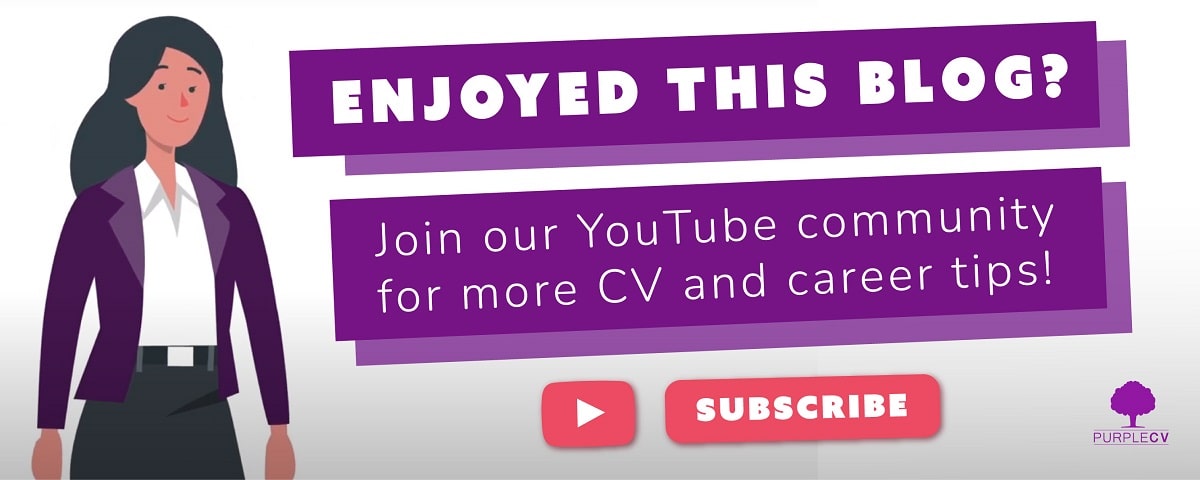You’ve been trawling jobs boards and LinkedIn – and the job description sounds perfect.
You’ve managed to avoid these common CV slip-ups but there’s just one more step to go: the dreaded cover letter.
Many job applicants we speak to seem to have a mental block when it comes to how to write a cover letter – and that shouldn’t be the case.
With this in mind, the PurpleCV team have brainstormed their top tips on how to write a cover letter that makes you stand out to recruiters and HR professionals alike.
What is a cover letter?
Okay, you might be a seasoned PurpleCV blog reader, or it may just seem obvious – but it’s crucial to understand exactly what is a cover letter, and why you need to write one, if you want to make yours stand out.
While your CV lays out the facts, your covering letter provides the chance to show a potential employer more of your personality.
This personal introduction is the perfect opportunity to build on the information in your CV and demonstrate why you’re a great candidate for a role.
For many employers, a cover letter is equally, if not more important than a CV – particularly in entry-level and graduate positions, where experience and skill levels maybe be similar across multiple candidates.
Indeed, even if a cover letter isn’t explicitly requested, we’d always recommend sending one. The extra effort you’ve taken immediately shows willing and that you’re enthusiastic.
Plus, it’s a golden opportunity to further show off your skills and experience.
Do your research
Our first top tip for how to write a cover letter is to do your research.
At the research stage you need to be thinking about:
The company
This is key. Understand the organisation’s profile: Where do they sit in the market? What projects have they been carrying out lately?
Visit their website and check the blog/news section for ideas. Are there any features of the company that particularly excite you or relate to your own interests and experience? Let the hiring manager know in your cover letter.
You can also check out their social media channels for a sense of company culture. This information can help inform the tone of voice you should adopt in your cover letter – more on that later.
The recruiting manager
A personalised letter is more likely to stand out than a generic “Dear Sir/Madam”.
By finding out their name you demonstrate initiative as well as genuine interest in the role.
You don’t need to be a trained detective to get hold of the information. Start by looking at the company’s website. It could be that their name is listed on there, in which case your job’s done.
If not, check social media such as LinkedIn or the business’ Facebook page. Alternatively, use an online search engine. If all else fails, call up the company and ask – it doesn’t hurt to get on the HR team’s radar.
The job description
It may have already caught your eye – but now is the time to go through it again – this time with a fine-tooth comb.
You should have already adapted your CV accordingly, and this is essential when you start talking skills and experience in your cover letter.
Sure, you’re not writing a dissertation, and it’s unlikely you’ll have space to cover every skill or requirement mentioned. Be analytical. Pick out the items mentioned in the job description that are both the best fits for your experience and appear the most crucial to the role.
Start strong
You want to set yourself apart from the pile of other applicants, and you only have a limited amount of time to do that.
Your first few sentences are thus the most important. Here are some tips to stand out:
Be direct
Hiring managers and recruiters see a lot of cover letters, and they don’t have time for fluff. Succinctness can go a long way when setting up the introduction of your cover letter.
Show excitement
People want to see that you are excited about working at their company. You want your enthusiasm to shine through in these first few sentences. All the research you have done will come in handy here.
Refer to an accomplishment
Hiring managers want to know that you’re up to the job. By highlighting a relevant achievement, you can demonstrate that you are prepared to successfully perform all job duties.
Get that cover letter written by us!
Cover Letter
Any Job ApplicationSkills and experience: show don’t tell
Our friends at The Society for Human Resources surveyed organisations on recruitment processes and found the top three things that must be included in a cover letter are:
- How a candidate’s work experience meets job requirements
- How a candidate’s skills meet job requirements
- Why a candidate wants to work at the organisation
To deliver this effectively, you must show, not tell.
At this point it might be useful to refresh your memory of the STAR method, covered in our recent blog on competency-based interviews.
Exemplify your experience and skills with hard facts and stats. How many leads did you convert in your six months as a sales lead?
What workflow systems did you introduce as a team manager?
Don’t be wishy-washy. Simply telling the recruiter you are determined is not the same as explaining how the challenging environment of the start-up you have been working in has honed your resilience.
Likewise, being “financially astute” counts for nothing if you can’t prove it’s the case with facts.
Why do you want to work at the organisation? Perhaps you’ve recently completed some voluntary work in a similar sector. You’ve completed an online course in HTML, or recently read an article by a key thought-leader in the field. Show some passion. Show you’re genuine. Anyone can say they’d love to work at a company – but not everyone can demonstrate that.
Think about anecdotes and examples that show multiple skills. It keeps things concise and are useful for revealing a bit of your personality too.
It goes without saying that you MUST be honest.
If you’re not and you get through to the next phase of the application, you will most likely get found out… making for a very awkward interview and no chance of being employed by the organisation in the future.
If you’re further down your career path and would like to make a career switch we have previously written about how to write a career change cover letter that is sure to help you with your transition.

How to write a cover letter: length, style, accuracy and formatting
Length is an interesting one as there are different opinions as to how long a cover letter should be.
While we appreciate you may have lots you want to say about yourself, you don’t want to be verbose.
Hiring managers aren’t likely to be able to devote much time to each letter, and one that is excessively long may be ignored straight off – or skimmed at the very least.
While expectations differ regionally, and by seniority of role, a survey in the United States revealed almost 70% of employers wanted a cover letter of less than a full page and about 25% said the shorter the better. Within this, 44% stated half a side was the ideal.
We mentioned tone-of-voice earlier in this article – and it stems back to your research into the company and the role. It may be obvious from their communications that a highly formalised tone isn’t necessary, and that’s fine. This may allow you to bring your personality more obviously to the fore.
NB: A bit of humour is great if you can pull it off – but avoid like the plague if you’re unsure. Making a hiring manager cringe is not a good first impression.
However, if it’s not clear, we’d suggest veering on the side of formal. This is a job application and respectful, non-colloquial language, isn’t ever going to be wrong.
Do your best to avoid clichés.
Rather than describing yourself as creative, try imaginative. You’re inventive, not innovative. You’re not determined, you’re tenacious. These word variations at least show that you can think beyond what the average applicant is willing to do.
Make sure you proofread, proofread, and proofread some more.
Go back over your cover letter as many times as you can stand and make sure there are no spelling, grammar or factual errors anywhere.
Not much will jar the reader more than spelling the company’s or the reader’s name wrong. Copy and paste every name or company title into a search engine and triple-check you haven’t misspelt it. That goes for the job title as well.
If possible, have a friend read it through. Sometimes it can be tricky to spot errors in your own work.
It’s rare that you’ll be sending a cover letter by post nowadays. Generally, you’ll be uploading to a recruitment portal or attaching to an email. We recommend you save your cover letter as a PDF file so that the document retains the proper formatting when it is opened and looked at.
Be sure to clearly save the file: name, role applied for, and date. Be especially careful with this if you’re adapting a cover letter you’ve used for a similar role.
Signing off: A call to action
Finish your letter on the right note.
Use the final few sentences to re-iterate why you’re the right person for this job.
Be grateful for the reader’s time – but feel free to express your hope to hear from them. There’s no shame in reminding them of your desire to progress in the application process.
Your sign-off will depend on the formality of your letter – this guide might prove helpful if you’re unsure on which is correct.
Summary: how to write a cover letter that makes you stand out
There’s a fair bit of info here, but don’t let it overwhelm you.
Begin with your research – that’ll direct the rest of the process.
As for the letter itself, it should go:
Memorable introduction
Specific, examples of relevant skills, experience and problems solved
Concise conclusion with a call to action
Finally, don’t forget your contact details!
Easy!
Applicants who aren’t so sure often turn to a template. Unfortunately, a personal document such as this is never going do itself justice as a template.
It may be that you do need to speak to an expert and if so, our team of CV writing specialists can also help with writing a cover letter tailored to the specific role you are applying for
Do get in touch for more details – and good luck with your application!


